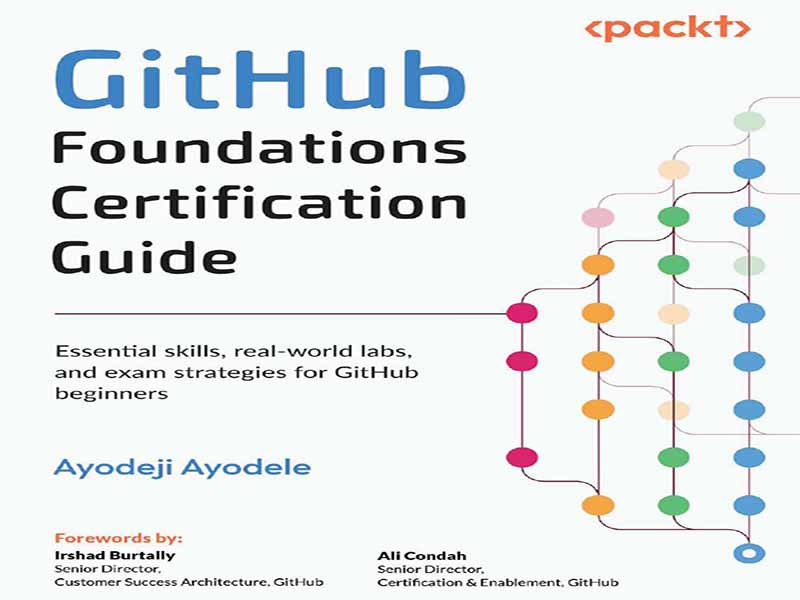- عنوان کتاب: GitHub Foundations Certification Guide -Essential skills, real-world labs, and exam strategies for GitHub beginners
- نویسنده: Ayodeji Ayodele
- حوزه: GitHub
- سال انتشار: 2025
- تعداد صفحه: 435
- زبان اصلی: انگلیسی
- نوع فایل: pdf
- حجم فایل: 6.75 مگابایت
این کتاب برای توسعهدهندگان نرمافزار و مهندسانی است که به دنبال تسلط بر Git و GitHub برای مدیریت کارآمد کد، همکاری در پروژه و گردشهای کاری ساده هستند. مهندسان زیرساخت و مدیران سیستم از یادگیری نحوه مدیریت اسکریپتها و پیگیری تغییرات زیرساخت بهرهمند خواهند شد. مربیان و مدرسان میتوانند از این راهنما برای آموزش توسعه نرمافزار و آمادهسازی دانشجویان برای گواهینامههای صنعتی استفاده کنند. توسعهدهندگان مشتاق و متخصصان فناوری، آن را منبعی ارزشمند برای ایجاد مهارتهای ضروری GitHub و پیشرفت در حرفه توسعه نرمافزار خود خواهند یافت. این کتاب برای توسعهدهندگان سطح مبتدی، مهندسان نرمافزار باتجربه، مهندسان پلتفرم و مدیران پروژه طراحی شده است و مسیری را برای فرصتهای شغلی هیجانانگیز فراهم میکند. اسپرینت ۰، آمادهسازی برای گواهینامه، به شما کمک میکند تا برای سفر گواهینامه آماده شوید و مقدمات و طرز فکر لازم را تشریح میکند. فصل ۱، مقدمهای بر کنترل نسخه با Git، مفهوم کنترل نسخه، اهمیت آن در توسعه نرمافزار و اصول اولیه Git را معرفی میکند. شما خواهید آموخت که چرا Git استاندارد صنعتی برای کنترل نسخه است و چگونه میتواند کارایی و همکاری در کدنویسی را به طور قابل توجهی بهبود بخشد. فصل ۲، پیمایش رابط GitHub، پلتفرم GitHub را بررسی میکند و به شما در درک رابط کاربری آن و یادگیری نحوه پیمایش در ویژگیهای مختلف آن کمک میکند. این فصل برای استفاده مؤثر از GitHub برای مدیریت پروژه و همکاری بسیار مهم است. فصل ۳، ایجاد و مدیریت مخزن، در مورد ایجاد و مدیریت مخازن GitHub، از جمله بهترین شیوهها برای نامگذاری، مقداردهی اولیه و صدور مجوز بحث میکند. فصل ۴، دستورات و گردشهای کاری پایه Git، شما را در مورد دستورات، پرچمها و گردشهای کاری Git متوسط، از جمله راهاندازی مخازن، ایجاد تغییرات، همکاری با دیگران و عیبیابی مشکلات رایج، راهنمایی میکند. شما یاد خواهید گرفت که چگونه از Git برای کارهای روزمره توسعه استفاده کنید و یک گردش کار روان و کارآمد را تضمین کنید. فصل ۵، استراتژیهای شاخهبندی و ادغام، مدل شاخهبندی و همچنین استراتژیهای شاخهبندی و ادغام در Git و GitHub را بررسی میکند و شاخهبندی ساختاریافته را برای همکاری تیمی و تکنیکهایی برای افزایش بهرهوری و کیفیت کد برجسته میکند. فصل 6، درخواستهای pull و بررسی کد، مفهوم درخواستهای pull و بررسی کد در GitHub را برای حفظ کیفیت کد و تقویت همکاری در توسعه نرمافزار توضیح میدهد. این فصل بهترین شیوهها را برای حفظ کیفیت کد از طریق بررسیهای همتا برجسته میکند. فصل 7، مسائل، پروژهها، برچسبها و نقاط عطف، یک راهنمای اولیه برای ابزارهای مدیریت پروژه GitHub ارائه میدهد که بر مسائل، برچسبها و نقاط عطف تمرکز دارد و شامل تمرینهای عملی برای افزایش درک و کاربرد است. همچنین به شما میآموزد که چگونه از این ویژگیها برای پیگیری پیشرفت و سازماندهی کار در یک تیم استفاده کنید. فصل 8، اقدامات و اتوماسیون GitHub، یک راهنمای مقدماتی برای اقدامات GitHub ارائه میدهد که نقش آن را در ادغام مداوم و تحویل مداوم (CI/CD)، مفهوم خط لوله به عنوان کد، مؤلفهها و اصطلاحات کلیدی، تمرینهای آزمایشگاهی عملی و بهترین شیوهها برای ایجاد و مدیریت گردشهای کاری پوشش میدهد. فصل 9، تعامل با جامعه از طریق بحثهای GitHub، در مورد بحثهای GitHub، یک ویژگی پلتفرم که تعامل جامعه را تقویت میکند، به شما آموزش میدهد. این فصل نحوه شروع بحثها، پاسخ به سؤالات و ایجاد یک جامعه پیرامون پروژهها را پوشش میدهد. فصل ۱۰، ایجاد و نمایش حضور GitHub شما، به بررسی چگونگی ایجاد و نمایش یک حضور حرفهای GitHub، از جمله ایجاد یک پروفایل برجسته، نمایش موثر پروژهها و مشارکتها و استفاده از صفحات GitHub برای برندسازی شخصی میپردازد. فصل ۱۱، مشارکت در پروژههای متنباز، نحوه مشارکت در پروژههای متنباز در GitHub را مورد بحث قرار میدهد و موضوعاتی مانند پیمایش چشمانداز متنباز، شناسایی پروژههای مناسب، درک مجوزهای متنباز و مزایای مشارکت در جامعه متنباز را پوشش میدهد. فصل ۱۲، افزایش توسعه با GitHub Copilot، تأثیر دگرگونکننده هوش مصنوعی مولد بر توسعه نرمافزار را بررسی میکند و بر قابلیتها، تنظیمات، کاربرد و بهترین شیوههای GitHub Copilot برای بهبود گردشهای کاری توسعه و ارتقای تجربیات کدنویسی تمرکز دارد. فصل ۱۳، تأمین مالی پروژههای شما با حامیان مالی GitHub، به شما میآموزد که چگونه حامیان مالی GitHub را راهاندازی و مدیریت کنید تا حمایت مالی برای پروژههای متنباز را تأمین کنید، از جمله ایجاد یک پروفایل حمایت مالی جذاب، تعامل با حامیان مالی و استفاده از سطوح حمایت مالی برای رشد پایدار پروژه. فصل ۱۴، مدیریت پروژه با پروژههای GitHub، راهنمایی در مورد استفاده از پروژههای GitHub برای مدیریت مؤثر پروژه است که شامل راهاندازی، سفارشیسازی، ویژگیهای کلیدی و اتوماسیون برای افزایش همکاری تیمی و کارایی گردش کار میشود. فصل ۱۵، شیوههای امنیتی و مدیریت کاربر، بررسی عمیقی از شیوههای امنیتی GitHub و مدیریت کاربر ارائه میدهد و موضوعاتی مانند احراز هویت دو عاملی، قوانین حفاظت از شاخهها، تنظیمات امنیتی را پوشش میدهد.
This book is for software developers and engineers looking to master Git and GitHub for efficient code management, project collaboration, and streamlined workflows. Infrastructure engineers and system administrators will benefit from learning how to manage scripts and track infrastructure changes. Educators and trainers can use this guide to teach software development and prepare students for industry certifications. Aspiring developers and tech professionals will find it a valuable resource for building essential GitHub skills and advancing their software development careers. It is aimed at entry-level developers, seasoned software engineers, platform engineers, and project managers, providing a pathway to exciting career opportunities. Sprint 0, Preparing for the Certification, helps you get ready for the certification journey, outlining the necessary preparations and mindset. Chapter 1, Introduction to Version Control with Git, introduces the concept of version control, its importance in software development, and the basics of Git. You will learn why Git is the industry standard for version control and how it can significantly improve coding efficiency and collaboration. Chapter 2, Navigating the GitHub Interface, explores the GitHub platform, helping you understand its interface and learn how to navigate through its various features. This chapter is crucial for utilizing GitHub effectively for project management and collaboration. Chapter 3, Repository Creation and Management, discusses creating and managing GitHub repositories, including best practices for naming, initializing, and licensing. Chapter 4, Basic Git Commands and Workflows, guides you through intermediate Git commands, flags, and workflows, including setting up repositories, making changes, collaborating with others, and troubleshooting common issues. You will learn how to use Git for everyday development tasks, ensuring a smooth and efficient workflow. Chapter 5, Branching and Merging Strategies, examines the branching model, as well as branching and merging strategies in Git and GitHub, highlighting structured branching for team collaboration and techniques to enhance productivity and code quality. Chapter 6, Pull Requests and Code Reviews, explains the concept of pull requests and code reviews on GitHub for maintaining code quality and fostering collaboration in software development. It highlights best practices for maintaining code quality through peer reviews. Chapter 7, Issues, Projects, Labels, and Milestones, provides a basic guide to GitHub’s project management tools, focusing on issues, labels, and milestones, and includes practical exercises to enhance understanding and application. It also teaches you how to use these features to track progress and organize work within a team. Chapter 8, GitHub Actions and Automation, provides an introductory guide to GitHub Actions, covering its role in continuous integration and continuous delivery (CI/CD), the concept of pipeline as code, key components and terminologies, practical lab exercises, and best practices for creating and managing workflows. Chapter 9, Engaging with the Community through GitHub Discussions, teaches you about GitHub Discussions, a platform feature that fosters community engagement. This chapter covers how to start discussions, respond to queries, and build a community around projects. Chapter 10, Building and Showcasing Your GitHub Presence, explores how to build and showcase a professional GitHub presence, including creating a standout profile, effectively showcasing projects and contributions, and utilizing GitHub Pages for personal branding. Chapter 11, Contributing to Open Source Projects, discusses how to contribute to open source projects on GitHub, covering topics such as navigating the open source landscape, identifying suitable projects, understanding open source licensing, and the benefits of contributing to the open source community. Chapter 12, Enhancing Development with GitHub Copilot, explores the transformative impact of generative AI on software development, focusing on GitHub Copilot’s capabilities, setup, usage, and best practices to enhance development workflows and elevate coding experiences. Chapter 13, Funding Your Projects with GitHub Sponsors, teaches you how to set up and manage GitHub Sponsors to secure financial support for open source projects, including creating an appealing sponsorship profile, engaging with sponsors, and leveraging sponsorship tiers for sustained project growth. Chapter 14, Project Management with GitHub Projects, is a guide on using GitHub Projects for effective project management, covering setup, customization, key features, and automation to enhance team collaboration and workflow efficiency. Chapter 15, Security Practices and User Management, provides an in-depth exploration of GitHub’s security practices and user management, covering topics such as two-factor authentication, branch protection rules, security configurations, managing access and permissions, and best practices for repository security. Chapter 16, Mock Exams and Study Strategies, includes deeper preparation tips, mock exam questions, study strategies, and tips for mastering Git and GitHub features.
این کتاب را میتوانید از لینک زیر بصورت رایگان دانلود کنید:
Download: GitHub Foundations Certification Guide





































نظرات کاربران